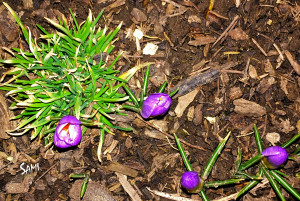 This week we have gone from temperatures in the 30s to the 60s and my poor little crocuses are blooming with snow coming in the next few days. But it made me think of spring and I remembered my photos of monarch butterflies in Maine. The shots were actually in the Fall, but the daisies were still blooming in the warm sunshine.
This week we have gone from temperatures in the 30s to the 60s and my poor little crocuses are blooming with snow coming in the next few days. But it made me think of spring and I remembered my photos of monarch butterflies in Maine. The shots were actually in the Fall, but the daisies were still blooming in the warm sunshine.

According to the Waterblog of the National Aquarium, the Monarch Butterflies inherently knows how, when and where to migrate across continents. On this beautiful day on the coast of Maine there were hundreds of butterflies. They were everywhere getting ready to migrate south.
About 60 million to 1 billion migrate from eastern North America to the Sierra Madre Mountains of central Mexico. These remarkable butterflies sometimes fly about 80 miles a day, spreading out their journey across two months.
Unfortunately, in the last 20 years, the Monarch butterfly popul ation has dropped by 90%. Part of the problem lies in the lack of milkweed. A perennial flowering plant, milkweed is critical to the butterflies’ survival. It provides nectar along the migration route and is the only plant on which these insects can lay their eggs. It is quickly disappearing from the Midwest as farmers cultivate more land for agricultural use. We can help by planting milkweed in our gardens. I got milkweed balls last fall from Amazon, Common Milkweed Seed Balls for Fall Planting Updated Fall 2015 Recipe (Asclepias syriaca) (50)
ation has dropped by 90%. Part of the problem lies in the lack of milkweed. A perennial flowering plant, milkweed is critical to the butterflies’ survival. It provides nectar along the migration route and is the only plant on which these insects can lay their eggs. It is quickly disappearing from the Midwest as farmers cultivate more land for agricultural use. We can help by planting milkweed in our gardens. I got milkweed balls last fall from Amazon, Common Milkweed Seed Balls for Fall Planting Updated Fall 2015 Recipe (Asclepias syriaca) (50) I also got Milkweed Seed Packet Assortment (6 Individual Seed Packets) Non-GMO Seeds by Seed Needs
As we get warm days, I look forward
 to helping these beautiful butterflies and enjoying them in my garden. I hope you enjoy. Safe journeys until we meet next week.
to helping these beautiful butterflies and enjoying them in my garden. I hope you enjoy. Safe journeys until we meet next week.



